Camping is a life-changing experience, and camping in the winter is even better.
Breath-taking view of the snow-clad mountains, sheets of white covering everything around you, and not to mention the cool, chilly breeze all around you.
Although it might seem impossible, camping in winter is quite fun!
Provided you have proper clothing and gear. Failing to pick out the right stuff can be dangerous. The winters are pretty but can be pretty harsh for campers who go unprepared.
Contents
Is Camping Possible During Winter?
The answer is YES! Camping is possible during winter. But there are some essential instructions that you must follow.
The snowy wilderness may seem majestic to the eye but can be cruel to your body. Summers are considered ideal for camping. The warm weather and long-lasting daylight make you feel safe.
High temperatures also make it easier for people to trek. You can see the path clearly and aren’t afraid of falling into crevices usually formed in the winter.
So why do people prefer winter camping? Well, winter camping has its perks!
First of all, the view is mind-blowing. Secondly, there are fewer bugs and insects during winter.
Winters are also much more peaceful than summers! The snow reduces the sounds around, and the best part is there are fewer people, which means you can pick from an array of camping spots.
The only thing you must avoid while camping in winter is going unprepared. If you are a first-time winter camper, make sure you do in-depth research on the dos and don’ts of winter camping. Going unprepared can have some solid repercussions!
How To Prepare For Winter Camping?
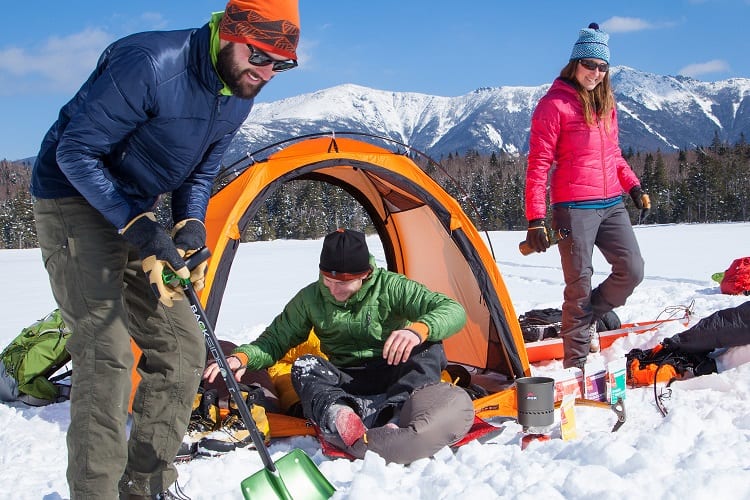
The first and most important thing while going winter camping is picking out the right time and destination.
Do not go too far up the mountain where there is absolutely no way to get help. If you are a beginner, pick a spot that is close to a resort. This way, even if things get wild, you can always return to a warm shelter.
Pick a location that is close to a water body, or else you will end up melting snow all night. It takes a lot more fuel to burn firewood in the winter. You don’t want to use up all your fuel melting snow.
Firewood is another essential resource needed for a fun winter camping trip. You want to pick a spot that has firewood around. You don’t waste time and energy finding and lugging firewood back to your camping spot this way.
Check the weather before you set a date for your winter camping trip. Bad weather can quickly turn hazardous. It will blow away your camp and leave you shivering in the cold. Snowstorms can be cruel to a human in a tent. Moderate snowfall is ideal for a winter camping trip.
Now that your camping spot is set, you can start picking out the appropriate winter gear. Layering is an essential aspect of winter camping. Unlike summer, you can never have too many layers when you go for a winter camping trip.
Ensure you have a snug-fit base layer, a warm insulating mid-layer, and a thick shell layer. Thermals make for great base layers. A fluffy or fleece jacket will retain your body heat and keep you from freezing. For the top layer, make sure to buy a good-quality mountaineering jacket. Light jackets will allow wind to seep into the other two layers.
If the wind gets into the base layer, it can cause hypothermia. That is not pleasant—the whole point of layering it is to avoid hypothermia. You should also wear three layers of pants.
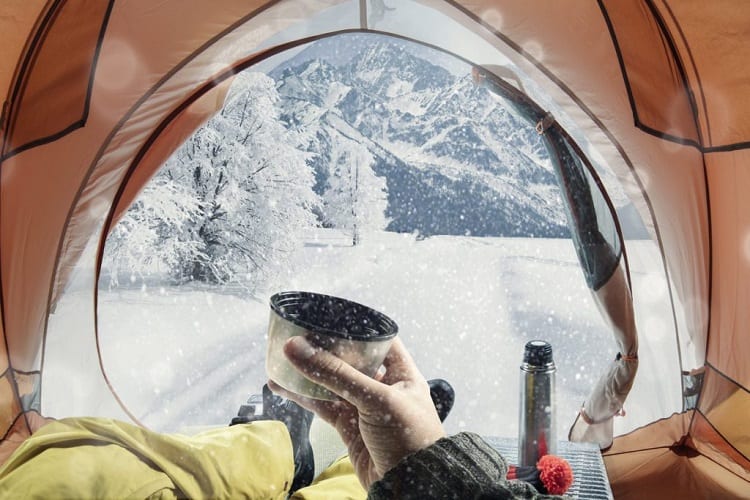
Thermals, leggings, and hiking pants are ideal for lower garments. Ensure there is enough space for you to move your legs and avoid chafing. The elastics of your pants shouldn’t be too tight as it can hinder circulation.
Camping in summer doesn’t require as many clothes as camping in the winter. Enjoying snowy scenery requires extra effort. Thick gloves and caps are a must. Although mittens provide more warmth, they restrict movement and have to be pulled off every time you want to do something. Choose the one that fits your needs perfectly.
You can also carry a woolen scarf to cover your neck. A sturdy pair of snowmobile boots are vital. They should be big enough to fit a few layers of socks. Your feet should have space and must not be cramped inside your shoes, as this can restrict circulation. The soles of your boots must have a firm grip. Snow makes the ground slippery, and you need to have a stronghold on the floor.
Now that you know what to wear for a winter camping trip, let’s move on to the right gear. A three-season sleeping bag is recommended. It will keep you from freezing. Nights are colder than a day, and your body temperature also drops during the night. So, a three-season sleeping bag is a must. You can take two sleeping bags and put one into the other.
A three-season tent is recommended. Tents keep you sheltered from the strong winter winds. A robust and good-quality tent will make sure you remain warm and safe. Don’t forget to take your hiking poles. They help you navigate better in snow-laden trails.
Some places have deep layers of snow, and hiking poles help understand how hard the ground is or how deep the snow is. Either way, these poles will be a blessing.
Canister or alcohol stoves work just as well as white gas stoves. White gas stoves are easier to use than the other two.
Pack a good amount of nutritious food. Your body burns more calories in the winter than it does in summer. More calories mean more food. It is your body’s natural response to winter. To produce more heat, it has to burn more calories. It means you will get quite hungry throughout the trip. Make sure to pack a lot of nutrition bars. They are easy to eat and do not require a stove.
Don’t forget to carry your sunscreens. Trust me; reflective snow can cause significant skin burns. Sunglasses are also essential, reflective snow can be blinding, and you don’t want to squint your way through the entire trip.
A durable water bottle, flashlights, matches, GPS navigator, a map, and a strong backpack are other winter camping gear you must carry!
Winter Nights and Camping
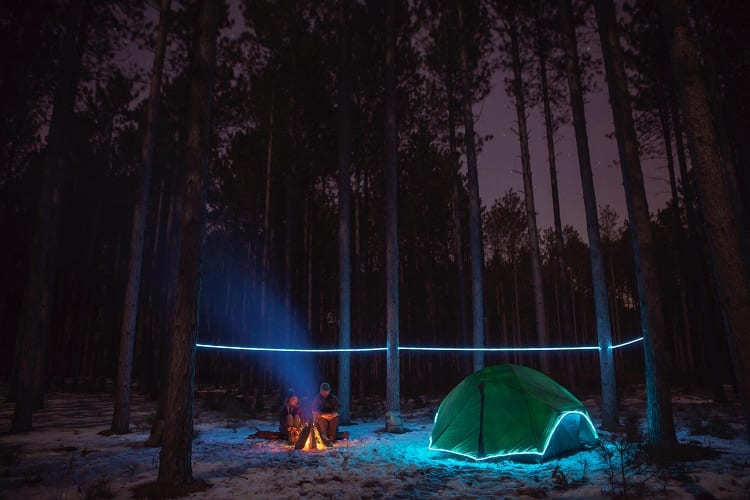
Winter days are manageable; it is the nights you need to prepare for!
During the day, as you are trekking, your body keeps generating heat. The heat is trapped by the insulation layers of clothing, keeping you warm throughout the trek. As you begin to slow down and start setting up camp, the heat produced by the body also starts reducing.
The best way to keep your body heat intact is to wear all the layers of clothing you have got for the trip. This way, your body will remain warm for a longer time. If your clothes are damp from sweat, make sure to change them before adding more layers.
Wet clothes will make you feel colder. You might not realize it instantly, but as your body temperature lowers, you will begin to freeze. Take a right-sized tent. A big tent will allow too much wind to settle inside. Take a big enough tent to fit you but small enough to be insulated.
Place layers underneath your sleeping bag. Don’t just rely on one sleeping bag; take at least two. Instead of just layering on top, add layers to the bottom. This practice will protect you from the cold ground. Keep your head covered. Most of the heat leaves your body through the head. Make sure to keep it warm; this will ensure your body remains warm.
When getting into your sleeping bag, do not put your face inside. Your breath produces moisture and dampens the sleeping bag. Keep your nose and mouth outside the bag and tuck your body in. To add additional heating to your bag, put hot water bottles inside it.
Hand warmers are an even better option. Right before you crash, place a few hand warmers inside your sleeping bag. This trick might seem simple, but it works like magic. Use lithium batteries instead of alkaline ones. They are light and last longer than NiMh batteries.
If you can, keep a warm fire burning outside your tent. Of course, if it is snowing, this will be hard. But a good fire will keep you warm throughout the night. Add layers of socks underneath your shoes. And if you are sharing a tent with someone, then huddle close together. Both your bodies will produce enough heat to keep you warm at night!
Tips For Staying Warm During Winter Camping
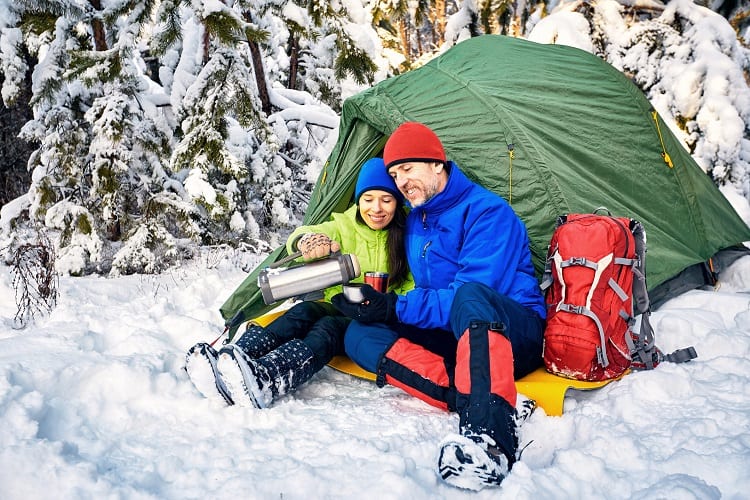
Thermals may seem old-fashioned, but they work like magic. A warm pair of thermals will keep your body heat intact.
A Long-sleeved shirt and leggings go a long way. Thermals are created explicitly for winters. They will keep you warm and work as a perfect base layer.
Another critical thing to remember is to layer up before you feel cold. Don’t wait for the cold to chill your bones. Add as many layers of clothing as you need to insulate your body heat. A hot water bottle is an absolute must. You can place it on your navel, never at the bottom of your feet.
It is easy to carry and provides warmth for a long time. A portable heater also works well. You can either use a portable electric heater or a gas heater. Make sure you exercise caution while using heaters. At no given point must the heater be left on while you sleep. It can cause several hazardous situations.
Invest in insulation. Use small tents and add layers of rugs or tent carpets on the ground. Tent carpets keep the tent insulated and protect you from the cold. If you wish to get up in the middle of the night, you do not have to step on the cold ground. A good old-fashioned rug will also work.
To keep your sleeping bag warm, add sleeping bag liners to it. You can use one made out of silk or fleece. Silk ones tend to rip easily, so a sturdy fleece one is preferred.
And the last tip is- do not go to bed cold. If you go to bed cold, you are likely to feel cold all through the night. Instead, go for a short-run, or chug a warm drink. Get your temperature up, insulate with layers and snuggle into your sleeping bag!
You can also buy heated gloves, heated boots, and hand warmers. Don’t underestimate winter nights in the open. It is better to pack more than to freeze all night.
Make sure you have small vents in your tent. It may sound counterproductive, but vents are essential so that the moisture created by your breath is vented out of the tent. Condensation inside the tent will make it damp and make you feel colder.
A balaclava is ideal for camping. Beanies and hats tend to slip off during the night. A balaclava will stay on and keep your head warm!
Safety During Winter Camping
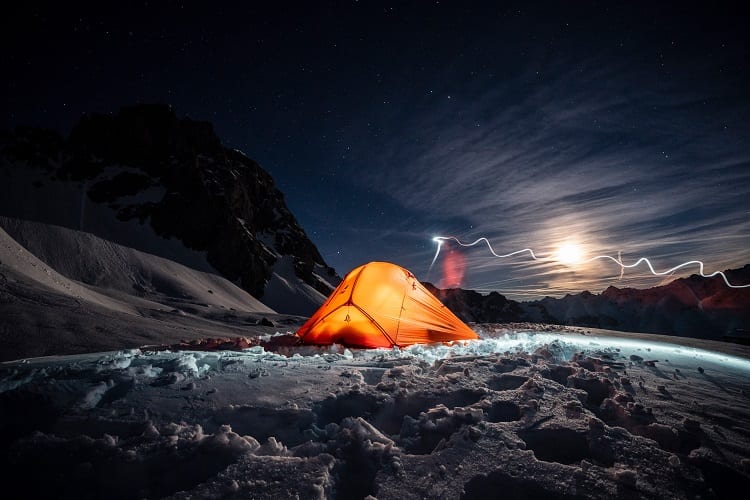
When choosing a spot to set camp, make sure you are in an avalanche-free zone.
It is always better to check the weather and pick a place that isn’t prone to avalanches. While trekking, if you come across a frozen water body, make sure to cross it carefully. The ice can be weak and might break under your weight.
Tread lightly on these areas. Always carry a GPS device with you. Snow can cause hindrance in navigation. A suitable GPS device will ensure you stay on the right track and don’t get lost in the snow.
There is less daylight during winter. It is ideal for planning your trek well so that you don’t get lost in the dark. You will have much less time than you might have in the summer.
Do everything you can to keep yourself warm. Eat lots of food and fill up on warm drinks. Wear layers upon layers to insulate body heat and keep your tent warm. Hypothermia and frostbites are a real thing. If you fail to keep yourself warm, you will suffer from either of the two.
Altitude sickness can also occur if you climb more than 1000 ft a day. If you feel yourself getting dizzy or nauseous, climb down to a lower altitude. Keep yourself hydrated. Winter fools you into believing you don’t need to drink water.
But dehydration is a serious problem. Campers want to avoid using the bathroom, so they do not drink water. It is not a good idea. Make sure to get plenty of water throughout the trip!
Conclusion
Winter camping trips are magical only if you are well prepared.
So, make sure you carry all the proper equipment along with multiple layers of clothing. Stay away from dangerous areas which are prone to avalanches! And most importantly, have fun.
Camping in the winter is an extraordinary experience; make the best of your winter camping trip in the snow.

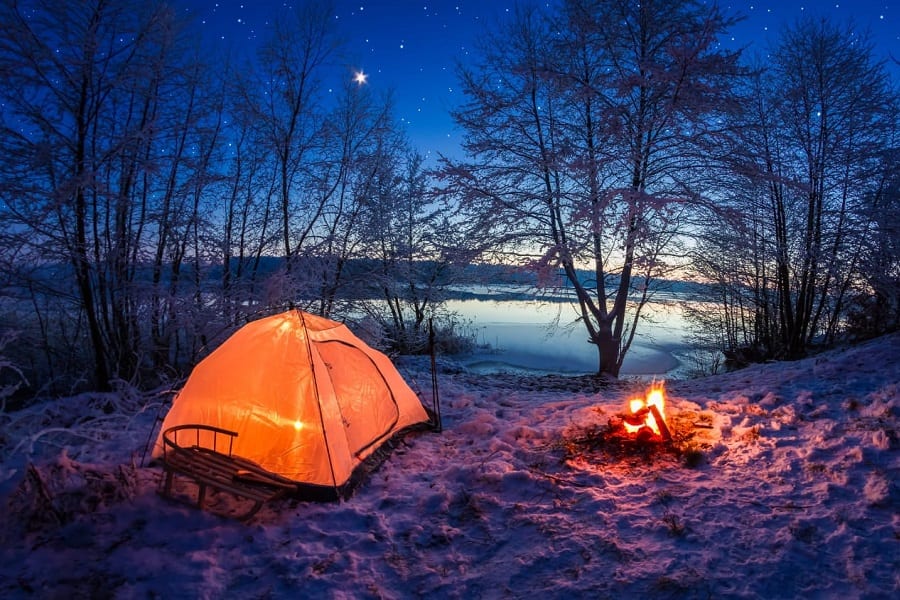

I think other website proprietors should take this web site as an model, very clean and fantastic user friendly style and design, let alone the content. You are an expert in this topic!
Your comment is awaiting moderation.